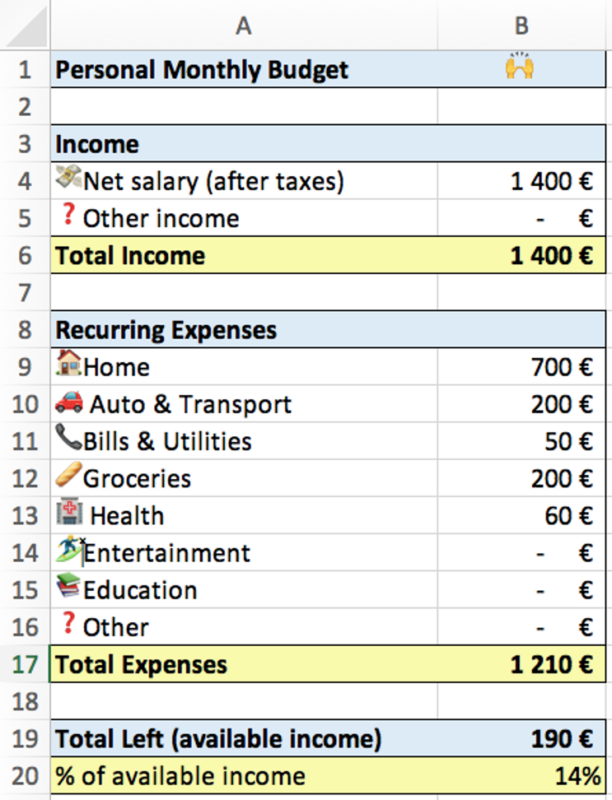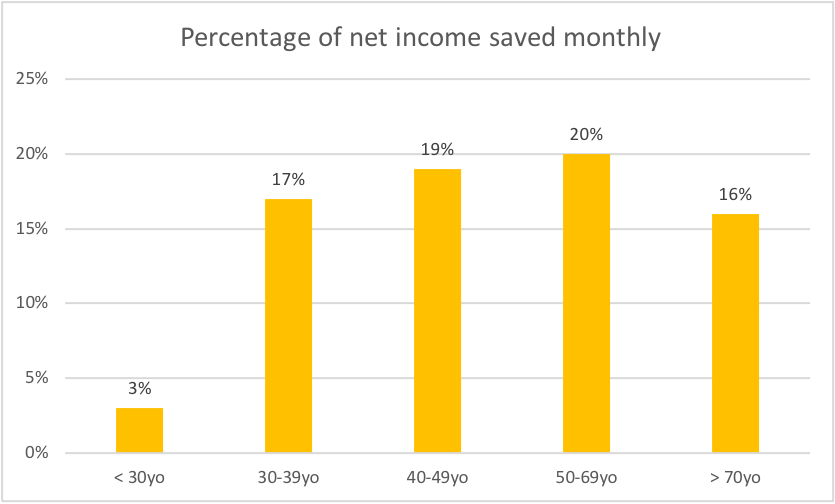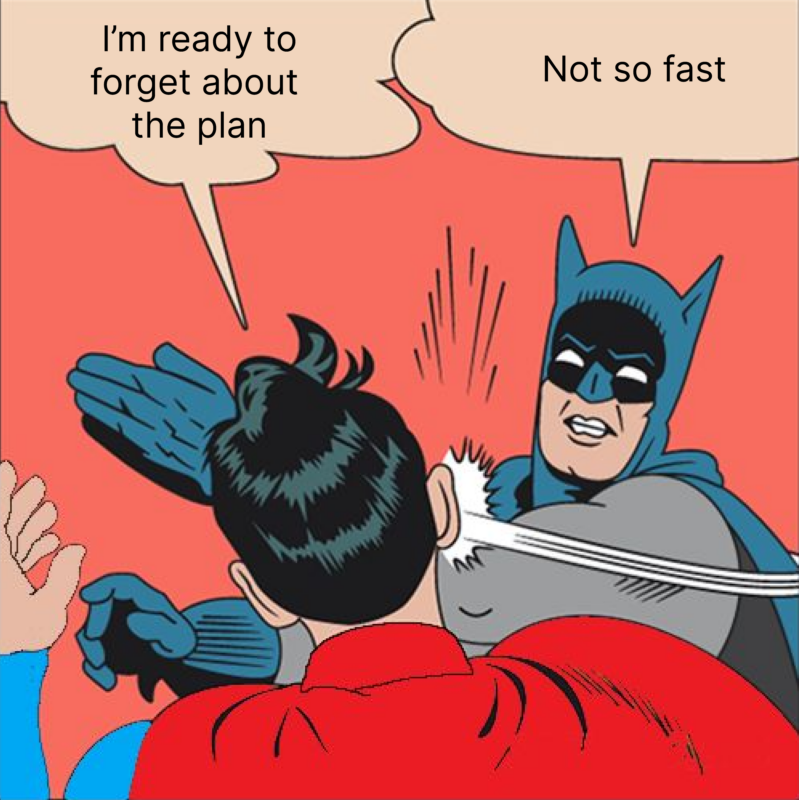In the US, 78% of people live paycheck to paycheck (CareerBuilder).
So what? You might say that this is working just fine if the bills are paid on time, right?
Unfortunately, life never goes as expected. How will you manage if we face a new pandemic or a financial crash? What will you do if you lose your job? If you live paycheck to paycheck, you could find yourself in very stressful situations.
Budgeting is essential to have visibility and control over your money. This is what you need to be financially safe, rather than living paycheck to paycheck.
The statistics speak for themselves: while 90% of Americans experience financial stress (ThriveGlobal and Discover), only 30% of them have a long-term financial plan (Gallup).
But a financial plan will not only make you safe. Far beyond that: it will shape what your future will look like.
Budgeting still sounds like a terrible word to you? Don’t worry. That’s what this article is here for.
You’ll be able to get started ASAP, with this step-by-step guide. We even added an Excel document for you to easily start your financial plan.
The purpose of this article is not to share a generic list of things. We want to give tools and methods adapted to YOU.
➯ Let’s start your financial journey now, like a pro. 😎
Part 1 – Tracking & Spending
Let’s get started!
Time to write down your income and expenses
Sit down with a nice cup of coffee/tea and cool background music. ☕
Take a sheet of paper, open Excel, or whatever tool works best for you.
➯ For the purpose of this exercise, we created a free Excel document to calculate your budget. You can just download it below.
Calculate your net income
Now that you’re ready to analyze, let’s start with your monthly income.
➯ How much do you earn each month? (make sure to include your salary and any other source of monthly income).

Calculate your recurring expenses.
Recurring expenses are the fixed costs that you have to pay each month.
Do not include one-time expenses, only fixed ones.
They can be split into the following categories:
- 🏠 Home (rent, mortgage, electricity, gas, water, etc.)
- 🚗 Auto & Transport (gas, car insurance, maintenance, parking, public transportation, etc.)
- 📞 Bills & Utilities (mobile phone, internet, Netflix, etc.)
- 🥖 Groceries (an average amount you spend on food and drinks)
- 🏥 Health (health insurance)
- 🏄♂️ Entertainment (monthly membership fee)
- 📚Education
- ❓ Other fixed monthly costs

Congratulations, you know how much money is left for you to spend, save and invest!
Now, what are other people doing? 🔎 According to Eurostat (2021), Europeans have an average available income equal to 5% of their net income (ouch). 🤯
➯ Now that you got some perspective, let’s move on to the most important part.
Part 2 – Make a plan (that is realistic)
Knowing your income and expenses is always good… But it’s not going to change anything if you don’t take concrete measures!
If you don’t do anything after receiving your salary check, things might get… out of hand. 🙈
Remember that feeling you get at the end of the month when you forget to save money?

We’ve all experienced the guilt of spending too much on unnecessary things and not saving money. But it does not have to be this way.
By following the next steps, you won’t have to experience the guilt of overspending, or forget to save money.
What is a good plan?
Three words: simple – personalized – fun
Yes, you must make sure to save enough money to be financially secure. But you can’t expect to save 100% of your available money.
We assume that you’re not a robot, but a human being with dreams, as well as personal and social needs. Right? This is why you need to find a good balance between saving money and enjoying life.
How to do that?
Step 1 - Introducing the concept of Emergency Fund
There is one basic rule that you must follow at all times: you must have an emergency fund.
What is an emergency fund?
An emergency fund is saved money that will save you A LOT of trouble in case you suddenly don’t have a source of income anymore.
The truth is, no one wants to have to use an emergency fund. It would be more fun to directly save money for your future holidays in Marbella.
But that’s not what you should do (unfortunately). Think about the last pandemic for instance. Since only 40% of Americans have enough savings to cover an unplanned expense of $1,000, imagine how the Covid-19 crisis impacted people’s financial security.
In order to be secure and confident about the future, you’ll need to create an emergency fund.
How to build an emergency fund
1) How much money should be allocated to my emergency fund?
To know that, first check your total expenses calculated earlier.
➯ Financial experts advise saving enough to cover 3 to 6 months of expenses. However, you can always go beyond these 6 months for extra security if you want to.
For some people, this might sound like a lot of money. Especially if you’re young and just got started. But remember this:
- you’ll be saving for this fund step by step. So that won’t affect your monthly spending drastically.
- You could start aiming at 3 months of expenses, and later on decide whether you want to continue saving for your emergency fund, or start saving for other purposes.
➯ At this step, you’ve decided how much money will be saved for your emergency fund.
2) Next step: how much money should you save and spend each month?
The 50-30-20 rule, a popular rule of thumb that we do not recommend
This rule was made by the US Senator and Harvard bankruptcy expert Elizabeth Warren.
The concept is simple: 50% of your total net income is spent on essential expenses, 30% of your money should be spent for fun, and 20% should be saved or used to pay your debt.

What’s wrong with this method? It simply doesn’t work for everybody.
=> Let’s show you 2 concrete examples:

➯ Low income – The example of Andrus
In this example, Andrus has 1100€ of net income.
According to the 50-30-20 rule, Andrus should spend 330€ for fun (1100 x 30%) and save 220€ (1100 x 20%).
▸ However, he only has 90€ of available money to spend and save. In his case, the 50-30-20 rule would be impossible to follow.
➯ Higher income – The example of Mike
Mike on the other hand earns 5,000€ a month.
According to the 50-30-20 rule, Andrus should spend 1500€ for fun (5000 x 30%) and save 1000€ (5000 x 20%).
▸ Obviously, the 50-30-20 rule is not ideal for everyone.
➯ Save your money in a way adapted to you
You’ve already calculated how much money you have each month.
Now, you need to decide the proportion of available income that you want to save and spend.
▸ This will depend on your situation to a large extent. Indeed, a study made by Eurostat showed that the percentage of money saved depends on many factors including your age:

➯ Let’s use the example of Andrus once again. He doesn’t have much money available. But he could still save a consistent part of it. Even if it’s just 10€. By doing it every month, he will slowly but surely build an emergency fund.
As for Mike, he could surely spend 1500€ per month on entertainment. But he could also decide to save and invest more than 30% of his total revenue.
➯ Whatever percentage of available income you’ll spend and save, there is no wrong answer. As long as you choose an option that is reasonably adapted to your financial and social needs. Otherwise, you won’t stick to it.
➯ At this step, you’ve decided how much money will be transferred to your emergency fund on a monthly basis.
Step 2 – Saving after building an emergency fund
First of all, if you’re here it means that you’ve already built your emergency fund. You can be proud of yourself!

From now on, you can save money for cool stuff. Do you fancy buying a van to travel around the world? Buying a new home or a new car? What is it that would make you TiC?
Since you’re experienced with saving for your emergency fund, it should be easy enough to save for things you’ll enjoy!
You could either keep saving the same percentage of money each month or decide to higher/lower this amount.
=> Do whatever feels right for you. And before you know it, you’ll be unstoppable.
=> At this step, you’ve decided how much money will be transferred to your savings account monthly.
Step 3 - Investing
For some people, investing sounds like an abstract and mysterious concept. For others, it’s something they absolutely want to do, even before saving any money. What about you?
Learning about investing is something we encourage as it can positively affect your life in the long run.
The types of investments you could make
- 📚Investing in yourself (embrace lifelong learning with books, courses, etc.)
- 💸Investing in Stocks, Bonds, Funds, etc.
- 📈Investing in Crypto
- 🏘️Investing in Properties
- 👑Investing in Precious Metal
How should you get started?
Since this article is meant for beginners, this will be the topic of a future article.
➯ Make sure to follow our newsletter to hear about it when it comes out!
Part 3 – Stick to your goals (for real!)

Now that you have a simple and actionable plan, how do you stick to it?
This is the last step you need to achieve your goals. Do not take it lightly. By following these tips, your financial journey will never be the same.
As soon as you’re paid, transfer money to a savings account
You should have one account for your emergency savings, and one account for extra savings that you plan to use in the future.
Make sure to have these 2 bank accounts ready.
After that, start the new routine.
➯ Every time you’re paid, take 2 minutes to transfer your savings to your emergency fund/saving account. In this way, you’ll never forget to save money ever again. 💪
Have a separate spending account
What is it for? Having a bank account dedicated to entertainment can be an amazing solution for several reasons:
- You will never spend money that was meant to be saved or used for monthly bills. You will be in control at all times, without thinking about it. This will already reduce a lot of financial anxiety.
- Get an account that won’t allow overdraft. In this way, once you’ve spent your entire budget, you will never pay bank overdraft fees.
- Get an account that enables you to set up a monthly and/or daily spending limit for extra control
- Bonus: with some bank accounts, you can earn rewards on all purchases. You will literally make money as you spend.
👉Psst… If you want to open a savings account that has all of these benefits, you’ve come to the right place. Download the TiC app on Android or iOS and open your spending account in minutes.
Conclusion
➯ From now on, you have all the necessary tools to start your financial journey like a boss.
By sticking to your plan and continuously learning new things about personal finance, you’ll be unstoppable.
As time goes by, you’ll have different incomes, expenses, goals, and dreams. Make sure to adapt your plan accordingly.
We wish you the best of luck on your journey to financial freedom!
For more financial tips, make sure to subscribe to our newsletter! 🙌

